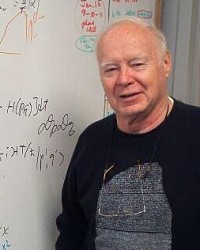John R. Klauder
(A Brief Biographical Sketch)
 Professor John R. Klauder was born in Reading, Pennsylvania, USA, on January 24, 1932. After graduating from the University of California, Berkeley, he joined Bell Telephone Laboratories, New Jersey, in 1953, where he worked on radar problems for three years and also attended night school at Stevens Institute of Technology, Hoboken, NJ, earning an MS in physics in 1956. From 1956-1959 he was a student of John A. Wheeler at Princeton University, NJ. After earning his PhD degree in physics, he returned to Bell Labs where he remained until 1988 at which time he joined the University of Florida in Gainesville as a Professor of Physics and also a Professor of Mathematics.
Professor John R. Klauder was born in Reading, Pennsylvania, USA, on January 24, 1932. After graduating from the University of California, Berkeley, he joined Bell Telephone Laboratories, New Jersey, in 1953, where he worked on radar problems for three years and also attended night school at Stevens Institute of Technology, Hoboken, NJ, earning an MS in physics in 1956. From 1956-1959 he was a student of John A. Wheeler at Princeton University, NJ. After earning his PhD degree in physics, he returned to Bell Labs where he remained until 1988 at which time he joined the University of Florida in Gainesville as a Professor of Physics and also a Professor of Mathematics.
Professor Klauder has been a visiting professor at the University of Bern (1961-62, 1980, 1996), Syracuse University, NY (1967-68), and was a Visiting Scientist at IHES, Bures-sur-Yvette in 1996. He served as the Lars Onsager Professor for Norway at NTNU in Trondheim, received the Lars Onsager Medal, and was elected as a foreign member of the The Royal Norwegian Academy of Sciences and Letters, all in 2006. Also in 2006 he became a Distinguished Professor of both Physics and Mathematics. In 2010 he was awarded an honorary doctorate by the Bogolyubov Institute for Theoretical Physics, Kiev.
Among other activities, Professor Klauder was a member of the National Science Foundation Physics Advisory Panel (1972 - 1975), Editor of the Journal of Mathematical Physics (1979 - 1985), Associate Secretary-General of the Executive Council of the International Union of Pure and Applied Physics (1985 - 1990), and President of the International Association of Mathematical Physicists (1988 - 1991).
Professor Klauder has made a number of important contributions to science over his career. Some highlights include: Klauder's often cited 1960 paper on chirp radar (with A.C. Price, S. Darlington, and W.J. Albersheim) was the first definitive work on the subject in the public literature. His thesis (published in 1960) introduced coherent states, an overcomplete family of genuine vectors having continuous labeling and a normal-appearing resolution of unity, and he pioneered their use in constructing coherent state formulations of path integrals for both bosons and fermions; later, these coherent states proved extremely useful in quantum optics. Coherent states were also used (1963-4) to promote novel quantization techniques, and they were used in the rigorous solution of so-called rotationally symmetric models (1965).
These latter models could not be solved by conventional techniques, as were additional models studied and solved by Klauder, namely, ultralocal scalar quantum fields (1970), ultralocal fermion quantum fields (1973). and independent-value field models (1975). He also introduced continuous-time regularization of phase space path integrals in 1985 (with I. Daubechies) that automatically generated coherent state representations and ultimately demonstrated that `quantization is geometry' (1988). In 1997 he introduced the projection operator method for the quantization of constraints, a procedure that treats all constraints (e.g., first and second class, (ir)reducible, (ir)regular, etc.) on an equal footing, offers a universally correct quantization procedure without using any auxiliary variables, and admits a natural path integral formulation. A new proposal for the quantization of Einstein's gravitational field (1999, 2001), which combined coherent states and the projection operator method, led to a continuous-time regularized functional integral formulation. Nonrenormalizability, which also plagues quantum gravity, may be understand as a hard-core phenomena (1973,1975) in which the interaction acts partially as a hard core within a functional integral, projecting out certain fields that are normally allowed by the free theory. As a test case, simpler than quantum gravity, the hard-core principle has been studied for nonrenormalizable, covariant scalar field models, and this has given rise (2007, 2009) to a plausible conjecture for a nontrivial quantization procedure for these traditionally insoluble models.
In addition to over 260 published articles, Professor John R. Klauder has (co)authored, or (co)edited six books:
- Fundamentals of Quantum Optics (with E.C.G. Sudarshan) (W.A. Benjamin, 1968 & Dover 2006)
- Magic Without Magic: John Archibald Wheeler (W.H. Freeman, 1972)
- Coherent States: Applications to Physics and Mathematical Physics (with B.-S. Skagerstam) (World Scientific, 1985)
- Coherent States: Past, present, and Future (with D.H. Feng and M.R. Strayer) (World Scientific, 1994)
- Beyond Conventional Quantization (Cambridge University Press, 2000 & 2005)
- A Modern Approach to Functional Integration (Birkhauser, 2010)